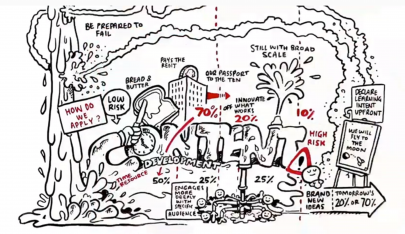 Why has Coke, one of the leaders in adopting new marketing techniques and technologies, embraced content marketing as their primary approach to engaging their audience?
Why has Coke, one of the leaders in adopting new marketing techniques and technologies, embraced content marketing as their primary approach to engaging their audience?
The always insightful Neil Perkin of Only Dead Fish recently called my attention to two videos (part 1 and part 2), where Coke explains their new marketing strategy, which they describe as “Content Excellence”. The videos are full of jargon and neologisms, but I think they represent an important trend, one that other brands will follow. It’s worth deconstructing the videos to look at where marketing, and specifically content marketing, is going in 2012.
What is Liquid and Linked Content?
Let’s begin with Coke’s distinction between liquid and linked content. The definition of linked content is pretty clear: content that is relevant to Coke’s business interests, their brands and to consumer interests. Liquid content is a clever name for a company that sells soda pop and other drinks, but for the rest of us, this would be more appropriately named “viral content” or content that provokes discussion.
“Content isn’t king. If I sent you to a desert island and gave you the choice of taking your friends or your movies, you’d choose your friends — if you chose the movies, we’d call you a sociopath. Conversation is king. Content is just something to talk about.” Corey Doctorow
The content we choose for content marketing isn’t just any content: it is content that provokes conversation, encourages sharing, educates. Only through conversation, sharing or education can it advance our business interests and those of our audience. To be successful as a marketing vehicle, content must possess both characteristics: it must be Liquid (conversation provoking, shareable, educational) and it must be Linked (relevant to our business interests or our customers).
Content that is funny or thought provoking, but not relevant to our business interests fails; similarly, content that is relevant to our business interests but is boring, hard to share or obvious also fails.
How Do We Generate Liquid and Linked Content?
So how do we generate content that is both Liquid and Linked? Coke provides some guidance, suggesting that we start with brand stories. In other words, Liquid and Linked content should possess the traditional elements of storytelling: compelling characters, plot, suspense, surprises, etc. They also suggest that we move from one-way to dynamic storytelling.
Perhaps the best example of this from the last few years is Weiden & Kennedy’s Old Spice commercials. They exhibit the traditional elements of storytelling (a compelling main character, surprises); the agency was also able to move to dynamic storytelling by asking viewers to post questions on popular sites like reddit, Facebook and Twitter for the “Old Spice Man” to answer.
How Do I Budget for Liquid and Linked Content?
Another insight I gained from watching these videos applies to how we budget for creating content. Jonathan Mildenhal, Coke’s VP of global advertising strategy, and the man behind these videos, suggests that brands allocate their budgets for content using the 70/20/10 rule:
- 70% of the budget, and 50% of our time, should go to bread and butter, low risk content generation
- 20% of the budget and 25% of our time should go to innovative content generating activities
- 10% of the budget and the remaining 25% of our time should go to high risk (and potentially high reward) content generating activities
What is the Role of Technologists in Generating Liquid and Linked Content?
The last element of these videos that I’ll cover (and I could write ten or fifteen blog posts on these two videos) is the potential for incorporating technologists into the core creative team. Too often, we think of content as written content, videos or perhaps podcasts. However, we should also think in terms of games and applications, which have the potential to be more immersive, and in many cases two-way. To create these games and applications, we need to work with technologists. Scott Brinker has written cogently about this trend on his blog.
Summary
To sum up:
- Successful content must be Liquid (viral, provoking conversation) and Linked (relevant to our brand’s or our customer’s interests)
- Successful content must adopt the elements of storytelling, and preferably dynamic, two-way storytelling
- We should distribute our investments in content using the 70/20/10 rule
- Increasingly, technologists will play a major role in content generation and in how we interact with our customers



Pingback: Developing a Content Strategy that Will Surely Help You Win Big in 2017 | AltusHost
Pingback: Strategija uz pomoć koje ćete dominirati u 2017. godini - unlimited.rs - Hosting visokih performansi | cPanel web hosting, VPS SSD, registracija RS domena